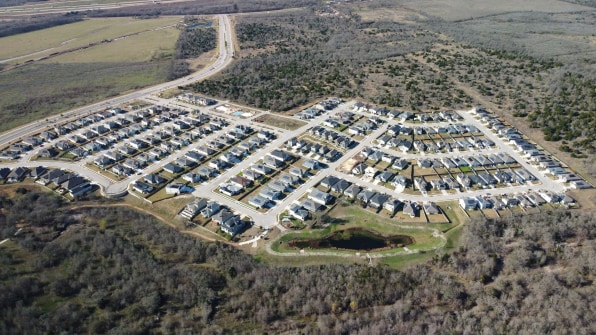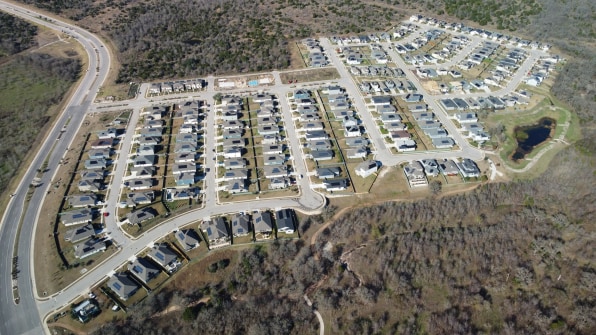As extreme weather becomes more common, reliable heating and cooling may start coming from underground ‘geogrids.’
BY NATE BERG
When uncommonly cold weather hit Texas in February 2021, the surge in energy demand knocked out the power grid, leaving millions of people without electricity or heat for days. The so-called Snowpocalypse was a catastrophe that left an estimated 58 people dead. For a few hundred residents in the east Austin subdivision Whisper Valley, though, the cold streak barely registered. While their neighbors across the state suffered, Whisper Valley residents had heat thanks to some very deep holes dug beneath their homes.
The houses in Whisper Valley, a development of about 200 homes, are powered by what’s being called a geogrid–an electricity-generating network using geothermal energy from deep below the surface of the earth. It’s a new way to think about powering neighborhoods. As extreme weather gets more destructive, it may also be a way for communities to withstand their own version of Snowpocalypse.
The geogrid at Whisper Valley was designed and built by EcoSmart Solution, which has several other neighborhood-scale geothermal energy grids in development across the U.S. The system is made up of wells bored below ground that tap the constant temperature found deep below the Earth’s surface. Using closed loops buried dozens or hundreds of feet below, these systems circulate liquid down and then back up into the home to create a baseline level of warmth, about 60 degrees. Electric heat pumps are then used to heat a home in winter or cool it in summer. Geothermal systems are notably efficient, requiring 70% less energy than a conventional heating system and 50% less than a typical air conditioner.

Closed-loop geothermal systems are a relatively new technology, but are often built as one-off solutions for individual homes. EcoSmart Solution’s geothermal grid expands the approach to the neighborhood or even community scale, using the power of hundreds of geothermal wells to provide heating and cooling, and even offset the extreme peak demands of a freak winter storm or hot Texas summer day. “We’re not using technology that’s very exotic,” says Greg Wolfson, chief technology officer at EcoSmart Solution. “It’s how we’re using it.”
Whisper Valley, developed by real estate investment firm Taurus Investment Holdings, is on its way to being the largest geogrid in the U.S., with plans to expand out to more than 7,500 homes geared toward first-time home buyers, with neighborhood amenities like schools, offices, and retail sites.
Large-scale geothermal systems have been built in other places, including housing developments in the United Kingdom and the Netherlands. In the U.S., Microsoft is currently building a massive geothermal system to power a 3-million-square-foot addition to its campus in Redmond, Washington, which will open in 2023.
From above, Whisper Valley looks like any other suburban subdivision of tract housing, but Wolfson says the way the neighborhood is powered is what sets it apart.
“The whole concept is to bring to the mass-produced home a lot of the attributes of sustainability and really drive down the energy consumption of the homes in that community,” he says.

In addition to the 200 homes now occupied, another phase of 200 additional homes has already been sold. Each has its own borehole, with a geothermal system connected to a heat pump. To offset the cost of digging these holes and building the geothermal systems, EcoSmart Solution drills en masse during the grading phase of development, when the site is being flattened and before any foundations have been laid. Once constructed, all the homes in the neighborhood are networked together to pool their heating and cooling capacity, controlled by a digital platform that tracks and redirects excess cooling or heating where it’s needed.
Wolfson says that, during that especially cold period in 2021, Whisper Valley’s geogrid proved its worth, especially compared to the conventional heating systems used by most buildings. “All of the equipment is protected from the environment. There’s nothing outdoors, it’s all under the home and underground,” he says. “Our water temperature coming into the homes was 60 degrees or above when the temperature outside was 9 degrees. So our heat pumps had no problem at all.”
Even without an extreme weather event, a geogrid can help a community greatly reduce its energy use. Wolfson says that all homes in Whisper Valley have added solar panels that work in combination with the geothermal system to bring monthly energy bills down to just $1.
Wolfson says it has taken some cajoling to get builders to understand how to integrate geothermal wells into their conventional housing developments, but he says pressure is mounting to include these energy efficient systems in more new projects. “It’s really turning into more of a requirement from investors,” he says.

